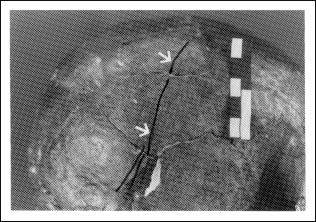by Maria O. Smith, Department of Anthropology, Northern Illinois University, and Research Associate, McClung Museum of Natural History & Culture
The origin and spread of the practice of scalping in the Americas has often been popularly linked with the colonial European practice of paying a bounty for enemy scalps. In actuality, the recorded initial contact of Native American peoples with European explorers (such as DeSoto and Cartier) attests to a well-established cultural context for scalping inconsistent with a European introduction. However, the westward expansion of Euro-Americans across the Great Plains is still often seen as the source for the practice among western Native Americans. The popular perception has always been that scalping has had a rather recent origin in the Americas, and the near universality of the practice attributed to Euro-American influence.
However, since 1940, infrequent but consistent reports of Pre-Columbian scalping victims (including west of the Mississippi River) in the anthropological literature have demonstrated that the practice does have a substantial antiquity in America. The earliest evidence published to date comes from a Middle Woodland Period site in western Iowa called the Hanging Valley site, which is dated from AD 200-800. In a 1988 article, the authors maintained the cut-marked individual was the earliest evidence of scalping.

Right parietal area of an individual from the Eva site, showing cut marks from scalping. Scale is 5 cm long.
This past summer, the McClung Museum anthropological collections yielded what is quite apparently even earlier evidence for the practice of scalping in the Americas. An individual from the Late Archaic Period (ca. 2500-1000/500 BC) Eva site exhibited the definitive cut marks around the crown of the head (see the Figure). The individual, a male aged 25-35 years, shows three sets of distinct, if superficial, cut marks across the right side of the head. This serendipitous discovery, made while this author was investigating another topic, prompted a more thorough examination of the Archaic material curated by the McClung Museum. In all, 219 individuals with complete or reconstructed crania were examined. A second corroborating scalping victim was found from the Kays Landing site. Both sites are located in what is now the Kentucky Lake Reservoir.
In the course of examining the collection for scalping, another site yielded evidence of a Late Archaic Period massacre. This information, coupled with evidence for inflicted projectile points at several sites and the trophy-taking practice of scalping, strongly argues for more complex intergroup relationships among what has been assumed to be peaceable hunter-gatherers. The discovery of the earliest scalping victim has evolved into a pilot study for a more comprehensive examination of warfare in the Archaic Period, scheduled to begin in the summer of 1992. The results of the pilot study have been submitted for publication.